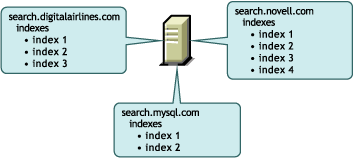1.3 Key Components of QuickFinder Server
Four key components are at the heart of the QuickFinder Server: virtual search servers, indexes, templates, and configuration settings. To understand how QuickFinder operates, you should understand the following three components.
1.3.1 Virtual Search Servers
A virtual search server is a completely independent search solution established for a single Web site, department, or organization. QuickFinder Server can support any number of virtual search servers from a single machine, and consists of the following components:.
-
A name and alias, which appear in your list of virtual search servers
-
Index files containing key words and related URLs for use in generating search results
-
Scheduled indexing events
-
HTML-based templates for highlighter, search, and print results
-
Log files
-
Configuration settings, such as stop words, keyword-redirects, synonyms, and security settings
-
Query reports
-
Admin interface
Each of these components is managed through the QuickFinder Server Manager, which is accessed through a Web browser. For more information, see Section 3.3.1, Components of a Virtual Search Server and Section 1.4, Managing QuickFinder Server.
Virtual search servers provide a method for categorizing similar information stores where each virtual search server is created for a specific purpose and audience. For example, you might create one virtual search server for your company’s support organization, another for its public Web site, and yet another for your intranet. You might break these down even further by creating more focused virtual search servers for groups within these organizations.
A typical QuickFinder server might have a dozen virtual search servers, each containing several indexes of its own.
Figure 1-2 A QuickFinder Server with Several Virtual Search Servers

You can have two or more virtual search servers share an index by creating a duplicate index on each virtual search server that points to the same index directory. In this manner, all virtual search servers can search a shared index in addition to their own indexes.
To create virtual search servers and generate indexes for them, you use the QuickFinder Server Manager, a browser-based utility. For more information, see Section 8.0, Creating and Managing Virtual Search Servers.
1.3.2 Indexes
An index is a file generated by QuickFinder Server that contains the key words and matching URLs gathered by QuickFinder Server from content located on file or Web servers. QuickFinder uses indexes to compile search results. You create one or more indexes for each virtual search server you create.
You can create two types of indexes: file system and crawled. When you want to index the contents of a file server, you create a file system index. When you want to index the contents of a Web server, you create a crawled index.
For more information about creating indexes, see Section 8.5, Creating Indexes.
1.3.3 Templates
A template is an HTML document containing one or more QuickFinder Server variables. Template variables are used to produce dynamic results when a user performs a search on the virtual search server you have defined.
Templates can be shared across virtual search servers or each virtual search server can point to its own set of templates.
For more information about templates, see Section 11.0, Understanding Templates.